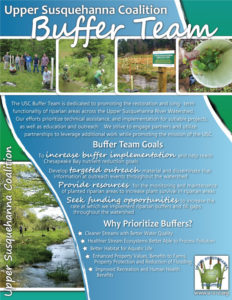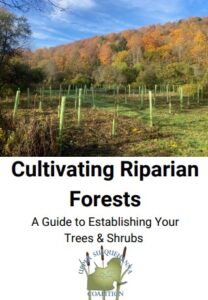USC Buffer Team
The goal of the USC Buffer Team is to promote the restoration and long-term functionality of riparian areas for water and habitat quality. These goals are achieved through innovative programming. The team is dedicated to ensuring practice functionality through education, outreach, and technical assistance.
Data collection to better understand buffer functionality is also a priority as is proving technical support of buffer issues to USC members. We strive to engage partners and utilize partnerships to leverage additional work to promote the mission of the USC.
Buffer Team Goals
- Continue to seek out and secure funding for stream corridor rehabilitation and prescribed grazing projects that include riparian buffers.
- Increase capacity to plan and coordinate riparian buffer projects within the USC geographical area.
- Collaborate with conservation partners to fill gaps within their programs to implement buffers.
- Support partners in their initiatives to implement riparian buffers.
- Lead a robust education and outreach agenda regarding water quality and the function of riparian areas.
Targeted 2024 Projects
Our goals are to sustain and bolster the buffer steward program with the intent of getting more maintenance done on newer projects. We’d like to obtain larger stock for projects so we can get some visible shade on streams faster. Since there are some new faces, we’re hoping to collaborate with partners on trainings for new and existing buffer team staff. Look out for Water Quality Symposium forestry track courses, a Plant Materials Center training in May, and the Pennsylvania Buffer Summit in June. Lastly, we are going to continue building staff capacity throughout the watershed.
Buffer Team Events
Buffer Team News
Local School Engages in Stream Sampling Ahead of Restoration Work
By: Lydia Brinkley On a beautiful sunny spring day, Morris Central School 9th and 12th grade science classes
Silvi-Corner: Nyssa sylvatica
By: Ava Glasser, Upper Susquehanna Coalition Nyssa sylvatica, also known as black gum or black tupelo, is a medium-sized
Cover Photo: Chesapeake Bay Program





